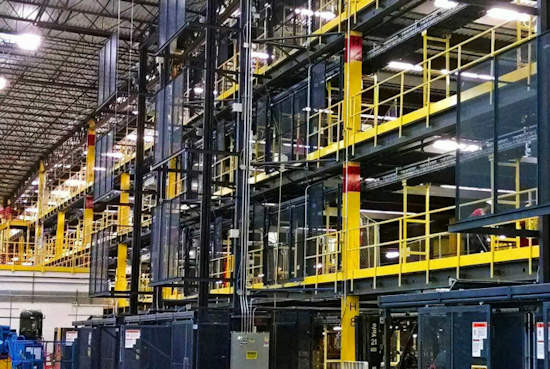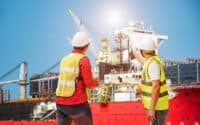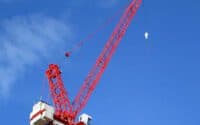Quick Compare: VRCs vs. Freight Elevators on Ships

In the bustling world of maritime shipping, where time is money, and efficiency is king, choosing the right type of elevator can make all the difference. It’s about moving goods safely, quickly, and smoothly from point A to B – inside the ship.
* Please send feedback/suggestions to editor @ shipuniverse.com
Understanding Cargo Ship Elevators
Types of Elevators in Cargo Ships: More Than Just Going Up and Down
Let’s dive into the world of cargo ship elevators. It’s not just about moving things up and down; it’s about doing it smartly.
- Freight Elevators: The heavy lifters. These elevators are designed to transport goods and cargo across different ship decks. Think of them like your robust, industrial-grade elevator, but on steroids.
- Vertical Reciprocating Conveyors (VRCs): These are more specialized. They move cargo vertically in a back-and-forth (reciprocating) motion. Ideal for heavy or bulky items that need to move straight up and down with precision.
Each type has its own superhero powers. Picking the right one? That’s where the magic lies for smooth sailing operations.
Key Features and Technologies: Elevating the Elevator Game
In the era of tech, cargo ship elevators aren’t left behind. Here’s what’s new and cool:
- Automation: It’s the 21st century, and manual labor is taking a backseat. Automated systems in elevators mean better efficiency and fewer human errors.
- Safety Features: From overload sensors to emergency brakes, modern elevators have safety dialed in. Because what’s more important than safe cargo (and people)?
- Energy Efficiency: With the green wave hitting all industries, cargo elevators are also going eco-friendly. Think energy-saving modes and more efficient motors.
- Durability and Reliability: The latest elevators are designed to withstand harsh marine environments. They’re like the rugged adventurers of the sea – built tough and reliable.
Freight Elevators: The Heavy-Duty Movers
The Backbone of Bulk Handling
Welcome to the world of Freight Elevators, the workhorses on board. These aren’t your average elevators; they’re built to lug massive loads across the decks of cargo ships.
- Design: Think strong, sturdy, and spacious. Freight elevators are designed with reinforced walls and floors to handle heavy, bulky cargo. They’re equipped with large doors to accommodate diverse cargo types – from pallets to vehicles.
- Capacity: They can carry tons (literally). Depending on the ship’s design, these elevators can hoist significant weights, often several tons at a time.
- Usage: Their primary role? To move cargo between decks efficiently. They’re particularly vital in large container ships and bulk carriers, where moving cargo quickly is key to maintaining tight shipping schedules.
Why They’re Special
- Customization: Depending on the ship’s needs, these elevators can be customized in size and lifting capacity.
- Durability: Designed to endure the harsh marine environment, they’re built with materials that resist corrosion and wear.
Vertical Reciprocating Conveyors (VRCs): The Precision Lifters
The Vertical Movers
Now, let’s talk about Vertical Reciprocating Conveyors (VRCs). These aren’t your typical elevators; they’re specialized for precise vertical movement.
- Function: VRCs are designed to move cargo up and down in a fixed path, unlike traditional elevators that may have multiple stops.
- Design: They come in various designs – hydraulic, mechanical, or fully automated systems. Think of them as elevators tailored for specific, heavy-duty tasks.
- Applications: Ideal for moving large, heavy items straight between decks, especially in ships where space is a premium. They’re great for items like machinery, large spare parts, or even vehicles.
How They Stand Out
- Precision and Control: VRCs offer controlled movement, which is crucial for handling sensitive or heavy cargo.
- Space Efficiency: Their design is often more compact, making them suitable for ships where space optimization is crucial.
Capacity Range: How Much Can They Lift?
The Lifting Limits of Cargo Elevators
In the world of cargo ships, one size definitely doesn’t fit all, especially when we talk about elevator capacity. Let’s break down what these elevators can handle:
- Freight Elevators: The muscle-bound lifters of the sea. These guys can typically handle anywhere from 1 ton to over 20 tons, depending on their design and the ship’s requirements. Some specialized freight elevators can even lift heavier loads, crucial for heavy machinery and large cargo.
- VRCs (Vertical Reciprocating Conveyors): While they might not carry as much as the largest freight elevators, VRCs still pack a punch. They’re typically designed to lift between 1 and 15 tons. Their strength lies in their precision and ability to handle bulky, awkwardly-shaped items.
Tailoring to Needs
- Customization: Remember, these capacities can be customized. The needs of the ship dictate the design – whether it’s a container ship needing a high-capacity elevator or a smaller vessel requiring a compact VRC.
Size and Space Requirements: Fitting It All In
Making Room for Movement
When installing an elevator on a cargo ship, it’s not just about lifting power; it’s also about how well it fits into the ship’s architecture.
- Freight Elevators: They usually require more space due to their larger capacity. This means considering not just the elevator shaft, but also the door opening, ceiling height, and the space needed for machinery like motors and controls.
- VRCs: Generally, they have a smaller footprint compared to freight elevators. Their design focuses on vertical movement, which often allows for more flexible installation options. However, like their bigger cousins, they still need space for their machinery and operational components.
Installation Considerations
- Ship Design: The type of ship greatly influences elevator design. For instance, container ships may have different spatial constraints compared to bulk carriers or oil tankers.
- Operational Needs: It’s crucial to balance the elevator’s space requirements with the ship’s cargo capacity and operational efficiency.
- Safety and Accessibility: Ensuring safe and easy access to the elevator is as important as its lifting capacity. This includes considering emergency access and operational safety standards.
Cost Factors: What Affects the Price Tag?
Diving into the Dollars and Cents
When it comes to outfitting cargo ships with elevators, the costs can vary widely. Let’s explore the factors that play into how much you’ll need to shell out.
- Size Matters: Bigger elevators with larger capacities generally cost more. It’s not just about the size of the elevator itself, but also the complexity of the installation.
- Capacity Counts: The weight an elevator can lift affects its price. Higher capacity often means more powerful motors and sturdier construction materials, all of which add to the cost.
- Tech & Features: The more bells and whistles you add, the higher the price. This includes automation technology, advanced safety features, and energy-efficient systems.
- Customization: Custom-built solutions to fit specific ship designs or operational needs can also drive up costs. The more tailored the elevator, the higher the expense.
- Installation and Integration: It’s not just the elevator; it’s also about integrating it into the ship. Complex installations that require structural modifications can significantly increase overall costs.
Cost Estimates: Ballpark Figures
Setting the Financial Sails
Here are some rough cost estimates. Remember, these are ballpark figures and can vary based on the factors we just discussed.
- Freight Elevators: For standard models, you might be looking at anywhere from $50,000 to over $200,000. The high-end models, especially those with larger capacities and advanced features, can go well beyond this range.
- VRCs: Generally less expensive than full-scale freight elevators, VRCs can cost between $25,000 and $100,000. Again, the price depends on capacity, technology, and customization.
A Note on Costs
- Long-Term Value: While upfront costs are important, consider the long-term value. A more expensive, energy-efficient model may save money in the long run through lower operational costs.
- Maintenance and Operation: Don’t forget to factor in the costs of maintenance and operation. Regular upkeep is essential for safety and longevity, which also involves ongoing costs.
Safety Features: Prioritizing Protection at Sea
Elevator Safety: Not Just an Afterthought
In the rough and tumble world of maritime transport, safety in cargo elevators is paramount. Let’s hoist up some key safety features and standards:
- Overload Sensors: These prevent the elevator from operating if the load exceeds its capacity, averting potential hazards.
- Emergency Braking Systems: Crucial for preventing accidents, these systems engage automatically in case of any operational failures.
- Manual Override Controls: In case of power failures or technical glitches, these controls allow for manual operation of the elevator.
- Regular Inspections: Compliance with maritime safety standards calls for regular inspections and certifications, ensuring all safety systems are up to par.
- Fire Safety Measures: Given the variety of cargo, fire safety systems, including alarms and suppression systems, are critical in cargo elevators.
Maintenance and Upkeep: Keeping Elevators Shipshape
Smooth Sailing with Regular Maintenance
To ensure cargo elevators continue to operate efficiently and safely, regular maintenance is a must. Here’s a guide to keeping them in tip-top condition:
- Routine Checks: Regular inspections by qualified technicians are crucial. These should cover mechanical parts, electrical systems, and safety features.
- Lubrication: Regular lubrication of moving parts helps prevent wear and tear, extending the life of the elevator.
- Cleaning: Keeping elevator components clean from dust, debris, and corrosion is essential, especially in the saline marine environment.
- Operational Testing: Frequent testing of the elevator under load conditions helps identify potential issues before they escalate.
- Record Keeping: Maintaining detailed records of inspections, repairs, and maintenance activities is vital for tracking the elevator’s health and compliance with safety regulations.
Common Issues to Watch For
- Wear and Tear: Regular wear is common but needs to be monitored to prevent major breakdowns.
- Corrosion: In the marine environment, corrosion is a constant battle. Regular checks for rust and decay are critical.
- Electrical Issues: Given the heavy-duty operation, electrical systems can be prone to issues and should be checked regularly.
Five Leading Suppliers
- North American VRC: Specializes in vertical reciprocating conveyors, as well as structural steel mezzanines and in-plant offices, focusing on expertise in VRCs.
- American Custom Lifts: Specializes in American-made freight lifts, offering a range of solutions including Vertical Reciprocating Conveyors (VRCs) designed for efficient material, tool, and equipment movement.
- Custom Industrial Products (CIP): Provides various VRC lift models and customizable solutions, with services including inspection, maintenance, and consulting to ensure optimal functioning.
- Schindler Elevator: A well-known provider of elevator solutions, including freight elevators, complemented by maintenance and repair services tailored to a wide range of building needs.
- MORN LIFT: Specializes in cargo lifts, particularly hydraulic-powered lifts with comprehensive safety features, and offers customized solutions based on specific site and work requirements.
- Wildeck: Known for their Vertical Reciprocating Conveyors (VRCs), offering material handling solutions for various industries to improve the movement of materials across different levels.
- CITI Elevator Inc.: Specializes in material lifts governed by safety standards, suitable for various applications including serving multiple landings and available in pit-less or ramp designs.
- Autoquip: Manufactures VRCs and freight lifts offering safe, economical, and reliable vertical lifting solutions within a small footprint, meeting or exceeding ASME B20.1 safety requirements.
- TK Elevator: Provides rugged, all-steel construction freight elevators with a variety of door options, customizable to meet specific demands of different operations.
- Wildeck: Offers Vertical Reciprocating Conveyors that are cost-effective, safe, and efficient for moving materials to mezzanines, rack storage systems, or upper floor levels.

Do you have a Maritime Product or Service that may be of interest to Shipowners? Tell us about it here!
Do you have feedback or insights? Please reach out to editor @ shipuniverse.com



